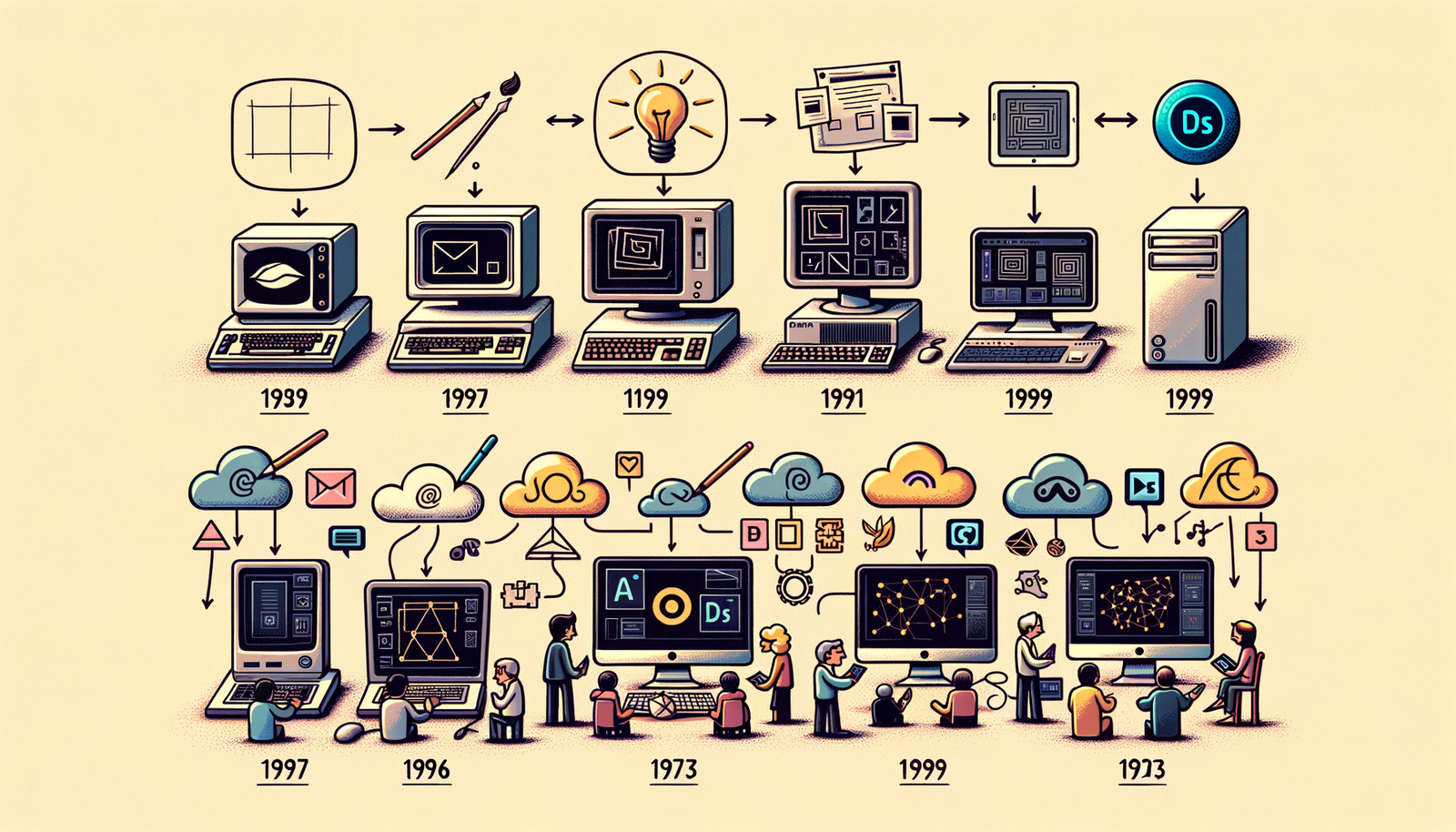Your Cart is Empty
Customer Testimonials
-
"Great customer service. The folks at Novedge were super helpful in navigating a somewhat complicated order including software upgrades and serial numbers in various stages of inactivity. They were friendly and helpful throughout the process.."
Ruben Ruckmark
"Quick & very helpful. We have been using Novedge for years and are very happy with their quick service when we need to make a purchase and excellent support resolving any issues."
Will Woodson
"Scott is the best. He reminds me about subscriptions dates, guides me in the correct direction for updates. He always responds promptly to me. He is literally the reason I continue to work with Novedge and will do so in the future."
Edward Mchugh
"Calvin Lok is “the man”. After my purchase of Sketchup 2021, he called me and provided step-by-step instructions to ease me through difficulties I was having with the setup of my new software."
Mike Borzage
Design Software History: Evolution of Design Software: From Sketchpad to AI and Cloud Collaboration
July 22, 2024 7 min read


Introduction
The history of design software is a tale of rapid transformation, innovation, and technological advancement. From the initial conceptualizations to the current sophisticated tools we use today, design software has continually evolved to meet the demands of professionals across various industries. Understanding the journey from the rudimentary beginnings to the powerful software of today provides insight into its current capabilities and future potential. Key milestones such as the introduction of Ivan Sutherland's Sketchpad, the development of solid modeling, and the emergence of cloud-based collaboration are pivotal moments that have shaped the landscape of design software.
Early Beginnings and Foundational Technologies
Ivan Sutherland's Sketchpad (1963)
One of the most significant milestones in the history of design software was the creation of Sketchpad by Ivan Sutherland in 1963. Sketchpad was groundbreaking as it introduced the concept of a graphical user interface (GUI) for computer-aided design (CAD). This innovation allowed users to interact directly with the computer using a light pen to draw on the display, a major departure from the punch cards and textual input methods of the time. Sketchpad's ability to create and manipulate geometric shapes laid the foundation for modern CAD systems and demonstrated the potential of computers to assist in the design process.
Sketchpad's influence extended far beyond its immediate capabilities. It inspired subsequent developments in CAD technologies, leading to the creation of more sophisticated design tools. The principles established by Sketchpad, such as interactive graphics and constraint-based design, became fundamental components of future CAD systems.
Emergence of Computer-Aided Design (CAD)
The 1960s and 1970s saw the emergence of early CAD programs, which began to gain traction in various industries. These programs were initially developed to assist with specific tasks such as drafting and circuit design. Companies like IBM played a crucial role in the early CAD market. IBM's efforts culminated in the development of the DAC-1 (Design Augmented by Computer) system for General Motors in the early 1960s. The DAC-1 system is often recognized as one of the first comprehensive computer-aided design systems and marked a significant leap forward in automated design capabilities.
Early CAD programs were relatively limited in their capabilities, focusing primarily on 2D drafting and wireframe modeling. However, they laid the groundwork for more advanced systems that would emerge in the following decades. Key players in this era of CAD development included IBM, General Motors, and a host of other companies and research institutions that recognized the potential of computer-based design.
Geometric and Solid Modeling Advancements
As the capabilities of CAD systems evolved, so too did the requirements of the industries that used them. One of the major advancements in CAD technology was the development of geometric and solid modeling. In the early days, CAD systems were primarily focused on wireframe models, which represented objects using lines and curves without any surface or volume information. While useful, wireframe models had limitations in terms of design accuracy and manufacturability.
The transition from wireframe models to surface modeling marked a significant improvement. Surface modeling introduced the concept of defining the exterior surfaces of an object, allowing for more accurate representations of complex shapes. This advancement was crucial for industries such as automotive and aerospace, where precise surface definitions were essential for aerodynamics and aesthetics.
The next major leap was the introduction of solid modeling. Solid modeling allowed designers to create three-dimensional objects with defined volume and mass properties. This was a significant breakthrough because it enabled more accurate simulations of real-world behaviors and ensured that designs were manufacturable. Solid modeling technologies, such as Boundary Representation (B-rep) and Constructive Solid Geometry (CSG), became the backbone of modern CAD systems. These advancements were pivotal in industries like mechanical engineering, where precise and functional designs were paramount.
Key Innovations and Industry Shifts
Introduction of Parametric and Feature-based Modeling
The introduction of parametric and feature-based modeling represented a paradigm shift in the way designers approached their work. Parametric modeling allowed designers to define relationships between different elements of a design. These relationships, or parameters, could be adjusted to automatically update the entire model. This capability provided a level of flexibility and efficiency that was previously unattainable.
Feature-based modeling, on the other hand, introduced the concept of designing objects using high-level features such as holes, fillets, and slots. This approach allowed designers to focus on the functional aspects of their designs rather than low-level geometric details. Companies like PTC and their flagship product, Pro/ENGINEER, were pioneers in this area. Pro/ENGINEER, introduced in the late 1980s, was one of the first CAD systems to fully embrace parametric and feature-based modeling, setting a new standard for design efficiency and customization.
Finite Element Analysis (FEA) and Engineering Computation
The integration of Finite Element Analysis (FEA) into design software marked a significant advancement in engineering computation. FEA is a computational technique used to predict how objects will react to external forces, such as stress, heat, and vibration. Before the integration of FEA into CAD systems, engineers had to rely on separate software tools and complex manual calculations to perform these analyses.
Companies like ANSYS and MSC Software were instrumental in developing and popularizing FEA tools. ANSYS, founded in 1970, became a leader in simulation software, providing engineers with powerful tools to analyze and optimize their designs. The integration of FEA into CAD systems allowed for seamless analysis and design optimization, enabling engineers to identify potential issues early in the design process and improve the overall performance and reliability of their products.
Advancements in Visualization and Rendering
Visualization and rendering technologies have also seen significant advancements over the years. Early CAD systems offered basic rendering capabilities, often limited to wireframe or simple shaded views. However, as the demand for more realistic and visually appealing representations grew, so did the capabilities of rendering engines.
Rendering engines like V-Ray, Maxwell Render, and KeyShot have played a crucial role in this evolution. These engines provided designers with the ability to create photorealistic visualizations of their designs, complete with accurate lighting, shadows, and materials. The ability to produce high-quality renderings allowed designers to better communicate their ideas to stakeholders, improve design reviews, and enhance marketing and presentation materials.
- V-Ray: Developed by Chaos Group, V-Ray is known for its high performance and realistic image output, making it a popular choice in industries such as architecture and product design.
- Maxwell Render: Created by Next Limit Technologies, Maxwell Render focuses on providing accurate lighting simulation and has been widely adopted in the fields of visualization and animation.
- KeyShot: Developed by Luxion, KeyShot is renowned for its ease of use and speed, allowing designers to quickly create high-quality renderings and animations.
Modern Developments and Future Trends
Additive Manufacturing and 3D Printing
The advent of additive manufacturing, commonly known as 3D printing, has revolutionized the design and manufacturing process. 3D printing technology allows for the creation of complex geometries and customized parts that would be difficult or impossible to produce using traditional manufacturing methods. This has had a profound impact on prototyping, enabling designers to quickly iterate and test their concepts.
Software innovations have played a key role in supporting additive manufacturing. Programs like Autodesk Fusion 360 and SolidWorks have integrated features specifically designed for 3D printing, such as tools for generating support structures and optimizing print orientation. These capabilities have streamlined the process of preparing designs for 3D printing and have made it more accessible to a broader range of users.
Rise of Artificial Intelligence and Generative Design
The integration of artificial intelligence (AI) into design software has opened up new possibilities for design optimization and innovation. Generative design is one of the most exciting developments in this area. Generative design leverages AI algorithms to explore a vast number of design possibilities based on defined constraints and goals. This approach allows designers to discover innovative solutions that may not have been conceived through traditional methods.
Autodesk has been at the forefront of generative design with tools like Autodesk Dreamcatcher and the generative design module in Fusion 360. These tools enable designers to input specific requirements, such as weight, material, and performance criteria, and the software generates multiple design alternatives that meet those criteria. This not only accelerates the design process but also leads to highly optimized and efficient designs.
Collaborative and Cloud-Based Design Platforms
The rise of collaborative and cloud-based design platforms represents a significant shift in the way design teams work together. Traditional CAD systems often required local installations and file-based collaboration, which could lead to version control issues and delays. Cloud-based solutions, such as Onshape and Autodesk BIM 360, have addressed these challenges by providing a centralized platform for real-time collaboration.
Benefits of collaborative design environments include:
- Real-time teamwork: Multiple users can work on the same project simultaneously, making it easier to coordinate efforts and share feedback.
- Version control: Cloud-based platforms automatically manage version history, reducing the risk of conflicts and ensuring that everyone is working with the latest version of the design.
- Accessibility: Cloud-based tools can be accessed from anywhere with an internet connection, allowing for greater flexibility and remote collaboration.
Impact of Open-Source and Community-Driven Projects
The growth of open-source design tools has democratized access to powerful design software. Projects like FreeCAD, Blender, and OpenSCAD have developed robust communities of users and contributors who continuously improve and expand the capabilities of these tools. Open-source software provides an accessible alternative to commercial CAD systems, making advanced design tools available to hobbyists, students, and professionals alike.
Community contributions are a significant aspect of these projects. Users can contribute code, develop plugins, and share their knowledge through forums and documentation. This collaborative approach fosters innovation and ensures that the software evolves to meet the needs of its users. The democratization of design software through open-source projects has the potential to drive further advancements and broaden the impact of design technologies.
Conclusion
The history of design software is marked by continuous evolution and innovation. From the pioneering work of Ivan Sutherland with Sketchpad to the latest advancements in AI-driven generative design, each development has built upon the previous ones, leading to the sophisticated tools we have today. Key milestones, such as the introduction of solid modeling, the integration of FEA, and the rise of cloud-based collaboration, have significantly shaped the landscape of design software.
As we look to the future, the potential for further advancements in design software is immense. Emerging technologies like AI, additive manufacturing, and open-source collaboration will continue to push the boundaries of what is possible. By staying informed about these developments and participating in the ongoing evolution of design tools, designers can leverage these technologies to create innovative and impactful solutions.
Also in Design News

Design Software History: From Plotters to Procedural Intent: A Technical History of Generative and Parametric Design Software
January 04, 2026 13 min read
Read More
Semantic Meshes: Enabling Analytics-Ready Geometry for Digital Twins
January 04, 2026 12 min read
Read MoreSubscribe
Sign up to get the latest on sales, new releases and more …



